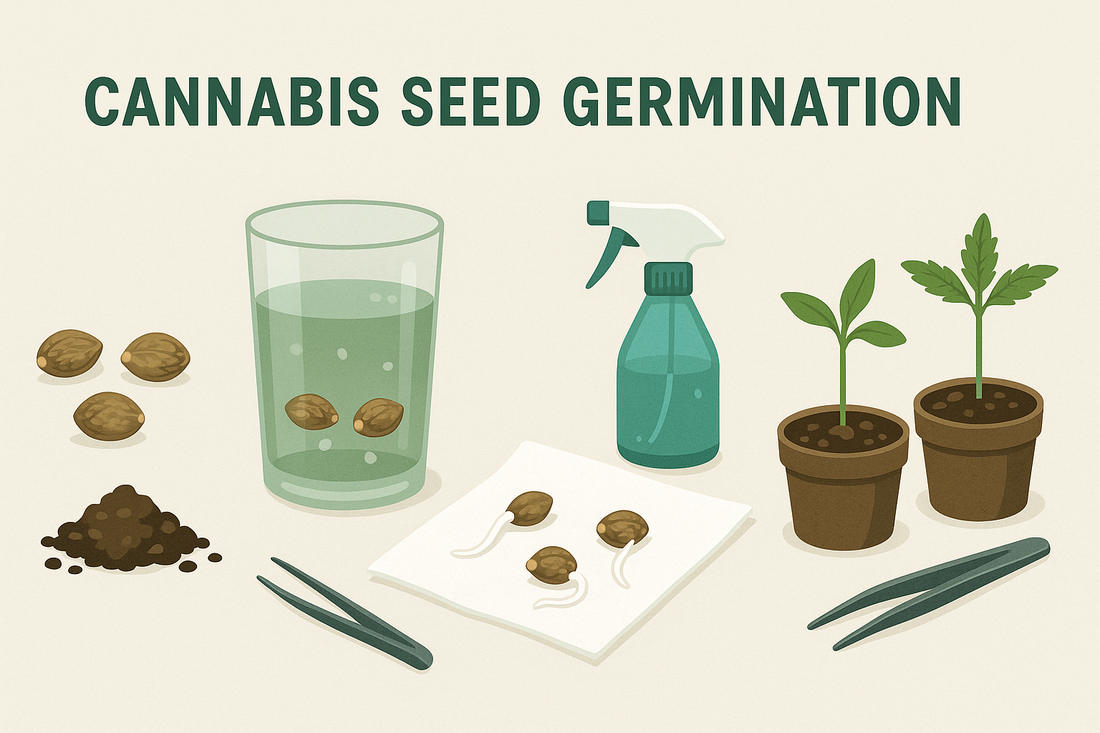
The Ultimate Guide on How to Germinate Cannabis Seeds
cannabis seeds can be a rewarding and fulfilling experience, setting the foundation for a successful grow. In this comprehensive guide, we'll walk you through each step, ensuring you have the knowledge you need to start your plants off right. Let’s dive in!
As the world of gardening and cultivation continues to expand, many individuals are exploring the rewarding experience of seed germination. At Skyline Seed Bank, we recognize that this process can be both exciting and challenging. However, we want to emphasize that seed germination should only occur in locations where it is legal. We do not endorse any actions that violate local laws, and our primary focus is on providing quality souvenirs and support for those interested in germinating seeds legally.
Understanding Seed Germination
Germinating seeds is an art that requires patience, knowledge, and a little bit of finesse. In nature, spring is the optimal time for seeds to sprout, as the warming temperatures and gentle rains create ideal conditions for growth. To successfully germinate seeds indoors, it’s essential to replicate these natural springtime conditions.
Creating the Perfect Environment
-
Temperature: Most seeds thrive in a warm environment, typically between 70°F and 85°F (21°C to 29°C). Consider using a heat mat or placing your seed trays in a warm area of your home to encourage germination.
-
Moisture: Seeds need moisture to sprout, but too much can lead to rot. Keep the soil consistently damp but not soggy. Using a spray bottle to mist the soil can help maintain the right moisture level without overwatering.
-
Light: Once the seeds begin to germinate, they will need plenty of light. If you don’t have a sunny window, consider using grow lights to provide the necessary light spectrum for healthy growth.
Common Pitfalls to Avoid
Germination can be tricky, and many new gardeners inadvertently complicate the process. Here are a few common mistakes to watch out for:
-
Overthinking: Sometimes, the best approach is to keep it simple. Excessive adjustments to conditions like temperature and moisture can hinder rather than help the germination process.
-
Over-caring: While it’s important to monitor your seeds, too much interference can disrupt their natural growth cycle. Allow your seeds to grow at their own pace.
What you gonna need:
- Cannabis seeds
- Drinking glass
- Bottled spring water
- Plates
- large ziplock bag
- Spray bottle
- Paper towels
- Tweezers
- Rubbing alcohol
- Pen or pencil
- Jiffy pellets
- Small pots
- Light soil mix
For best results, use rubbing alcohol to sanitize your tweezers. Consider setting up a germination station with a heat pad and humidity dome to accelerate the process and enhance your chances of success. While we won't mention soap here, it's essential to thoroughly wash your hands before handling seeds or plants.
Step 1: Soak Overnight
The first step in germinating cannabis seeds is soaking them overnight. This simple yet crucial action helps to kickstart the germination process. If you have multiple packs of Overgrow's world-class seeds, be sure to keep them separate—label each pack clearly.
Instructions:
- Get a clean glass or specimen jar.
- Fill it with store-bought spring water (avoid chlorinated tap water for old seeds a 1% hydrogen peroxide and water mix works great!), leaving it about half to two-thirds full.
- Drop your seeds into the water and let them soak for 12-18 hours.
- Keep the glass out of direct sunlight in a warm area indoors (ideally between 20-28°C).
During this soak, you may notice the radicle or taproot beginning to emerge from some seeds. This is a good sign that germination is underway!
Step 2: Using The Paper Towel Method
While some growers plant directly into soil, the paper towel method is highly effective for monitoring seed development.
Instructions:
- Lay two sheets of paper towel on a plate.
- Using clean hands or sanitized tweezers, place your seeds at least 2cm apart.
- Lightly spray the bottom sheets with spring water, then cover the seeds with another double-layer of paper towel and spray again.
- Ensure the towels are moist but not drenched.
5. Place paper towls into a zip lock bag or a humidity dome
Check the seeds twice a day to monitor their progress. Be gentle when inspecting; the delicate taproots can easily break if they get caught in the paper.
Step 3: Precision & Patience
Patience is key during this stage. Keep your workspace clean and your tools sanitized. Regularly check the paper towels to ensure they remain moist.
Seed Sprouting Time:
- Some seeds sprout within 12-48 hours, while others may take up to a week.
- Once the taproots reach about 0.5-1cm, they are ready to be planted.
Step 4: Plant in Jiffy Pellets or Soil
Transplanting your germinated seeds is a critical step. We recommend using jiffy pellets made from coco coir, as they provide an ideal balance of aeration and moisture.
Instructions:
- Pre-soak your jiffies in mineral water for about an hour.
- Prepare small pots (about 10cm in diameter) with light soil or a special seedling mix, leaving 1cm empty at the top.
- Create a hole about 0.65cm deep in the jiffy or soil.
- Carefully place each seed taproot down in the hole, and gently cover it with soil.
Water lightly after planting, and remember that cannabis seedlings don’t require nutrients for at least the first 14 days.
Step 5: Place Under Direct Light
Now it's time to introduce your seedlings to light. Depending on the temperatures, you may choose to keep them indoors under grow lights or place them outside gradually.
Lighting Setup:
- Use a fluorescent or compact fluorescent light (CFL) about 15-20cm above the seedlings.
- Alternatively, LEDs can be hung 60-90cm above, while HPS or MH lights should be kept at a greater distance.
Seedlings may emerge with their seed shells still attached—don’t interfere unless absolutely necessary. Wait a couple of days to allow the cotyledons to shed the shell naturally.
Step 6: Know Your Environment
Awareness of your growing environment is crucial. Pests and diseases can wreak havoc on your precious plants.
Preventative Measures:
- Research common pests that affect cannabis plants, such as birds, snails, and caterpillars.
- Implement preventive strategies to protect your seedlings, especially when growing outdoors.
Essential Germination Guidelines
When germinating cannabis seeds, keeping a few key factors in mind can help you avoid common pitfalls. While we've mentioned some of these in the previous steps, it's crucial to highlight the following points:
Temperature: In their natural environment, cannabis seeds typically germinate in spring, coinciding with rising temperatures. However, germination timing varies based on your unique South African climate. Aim to germinate your seeds within a temperature range of 21-29°C, considering nighttime temperatures as well. High humidity is also beneficial for successful germination.
Indoors: To align with the temperature guidelines mentioned, starting seeds indoors is advisable, especially if you reside in a cooler climate or plan to sprout seeds early for a head start on the outdoor season. Germinating indoors protects your seedlings from adverse weather conditions, such as wind and rain, as well as pests and predators.
Sunlight: While soaking seeds overnight, keep the glass and paper towel plates out of direct sunlight. However, once you plant the sprouted seeds in a jiffy or directly into the soil, direct light becomes crucial. This helps the cotyledons reach upward without stretching excessively in search of light.
Germination Station: To maximize your growing season, many savvy outdoor cultivators start their seeds indoors for an early advantage before transferring them outside. Regardless of where your plants will eventually thrive, a germination station equipped with a heat pad and humidity dome can enhance the sprouting process and improve overall success.
Water Quality: It's important to note that tap water is not always ideal for plants due to chemicals like chlorine and fluoride, which are added for sterilization. These chemicals can harm both human health and plant life, potentially hindering germination success. We recommend using high-quality, unaltered spring water for sprouting and early-stage watering. Additionally, consider aerating your water with an airstone for at least 24 hours.
Water Quantity: Seeds thrive in moist conditions, but it's easy to overwater and risk drowning them—whether through prolonged overnight soaks, oversoaking paper towels, or saturating newly planted seeds. Conversely, avoid allowing your medium to dry out. The key is to maintain a "light but frequent" watering approach.
Fragile Newborns: Approach your seedlings with the care of a surgeon. Wash your hands and sterilize your tools, avoiding heavily perfumed sanitizers; rubbing alcohol works well. Handle your seedlings with extreme caution during planting, as their survival depends on your careful touch.
A Note on Viability: At Skyline Seed Bank we utilize specialized refrigeration to keep our seeds viable. While you may read that cannabis seeds must meet specific size or appearance criteria, we can attest that they come in a variety of shapes, sizes, and colors. All our genetics are sourced from reputable and renowned breeders
Conclusion:
Germinating cannabis seeds demands careful attention, precision, and a touch of patience. By following these outlined steps, you can set your plants up for a robust beginning.
It’s important to note that most germination failures stem from human error rather than issues with the seeds themselves.
This method has attained an impressive 98% germination rate across seeds from various breeders and seasons. While it may seem elaborate and simpler alternatives exist, this approach consistently delivers optimal results, ensuring you achieve high germination rates when you stick to these guidelines.
We recommend joining the Skyline Grower Sessions Facebook group, for guidance and education on cultivating exceptional cannabis and hemp. This platform is designed to facilitate learning and enjoyment.
For all your cannabis seed needs and expert guidance, visit Skyline Seed Bank, where we offer a wide selection of quality seeds from some of the worlds best breeders.
For all your growing needs be sure to visit Skyline Grow Shop.
